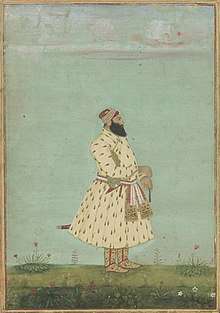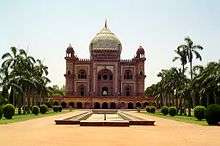Safdar Jang
- For the districts in Delhi, see Safdarjung (Delhi).
| Safdar Jung | |
|---|---|
|
Mirza (Royal title) Nawab of Oudh Nawab Wazir al-Mamalik Wazir ul-Hindustan (Prime Minister of India) Subedar of Kashmir, Agra & Oudh Khan Bhadur Meer-e-Atash Firdaus Aaramgah[nt 1] | |
 | |
| Reign | 19 March 1739– 5 October 1754 |
| Predecessor | Saadat Ali Khan I |
| Successor | Shuja-ud-Daula |
|
Full name
Abul Mansur Mirza Muhammad Muqim Ali Khan Safdar Jang | |
| Born |
1708 Nishapur, Khurasan, Persia |
| Died |
5 October 1754 Sultanpur, India |
| Buried | Safdar Jang's Tomb, Safdar Jung road, New Delhi |
| Spouse(s) | Amat Jahan Begum |
| Father | Siyadat Khan [Mirza Ja’afar Khan Beg] |
| Religion | Shia Islam |
| Military career | |
| Allegiance |
|
| Service/ | Nawab of Awadh |
| Rank | Subadar |
| Battles/wars | Mughal-Maratha Wars |
Abul Mansur Mirza Muhammad Muqim Ali Khan better known as Safdar Jang (Urdu: صفدرجنگ, Hindi: सफ़्दरजंग),(b. c. 1708 – d. 5 October 1754), was the Subadar Nawab of Oudh (the ruler of the Indian state of Oudh, also known as Awadh) from 19 March 1739 to 5 October 1754.[1] He was a descendant of Qara Yusuf from the Kara Koyunlu.
Biography
In 1739 he succeeded his father-in-law and maternal uncle, the Burhan ul Mulk Saadat Ali Khan I to the throne of Oudh, apparently by paying Nadir Shah twenty million rupees. The Mughal Emperor Muhammad Shah gave him the title of "Safdar Jang".[2]
Safdar Jang was an able administrator. He was not only effective in keeping control of Oudh, but also managed to render valuable assistance to the weakened Muhammad Shah. He was soon given governorship of Kashmir as well, and became a central figure at the Delhi court. During the later years of Muhammad Shah, he gained complete control of administration in the Mughal Empire. When Ahmad Shah Bahadur ascended the throne at Delhi in 1748, Safdar Jung became his Wazir ul-Mumalik-i-Hindustan or Chief Minister of Hindustan. He was also made the governor of Ajmer and became the "Faujdar" of Narnaul. However, court politics eventually overtook him and he was dismissed in 1753.[2] He returned to Oudh in December 1753, and made Faizabad military headquarter. He died in October 1755 at the age of 46 years in Sultanpur near Faizabad.[2]
Tomb

Safdar Jang's Tomb was built in 1754 and is situated on a road now known as Safdar Jang Road, in New Delhi.[3]
Several other modern structures near the tomb also carry his name today like Safdar Jang Airport and Safdar Jang Hospital
See also
References
- ↑ Princely States of India
- 1 2 3 HISTORY OF AWADH (Oudh) a princely State of India by Hameed Akhtar Siddiqui
- ↑ "Safdar Jang Tomb Garden". Archived from the original on 27 September 2007. Retrieved 28 March 2007.
Notes
- ↑ title after death
External links
![]()
- The complete genealogy of Safdarjung can be found here.
- Indiacoins has an article on Safdarjung here.
- Tomb of Safdarjung .
| Preceded by Borhan al-Molk Mir Mohammad Amin Musawi Sa`adat 'Ali Khan I |
Subadar Nawab of Oudh 1739–1748 (1st time) |
Succeeded by post abolished |
| Preceded by new creation |
Nawab Wazir al-Mamalik of Oudh 1748–1753 (acting to 29 Jun 1748) |
Succeeded by post abolished |
| Preceded by new creation |
Subadar Nawab of Oudh 1753–1754 (2nd time) |
Succeeded by Jalal ad-Din Shoja' ad-Dowla Haydar |